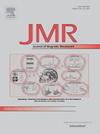On the geometric phase effects on time evolution of the density matrix during modulated radiofrequency pulses
IF 2
3区 化学
Q3 BIOCHEMICAL RESEARCH METHODS
引用次数: 0
Abstract
In this work the effect of the geometric phase on time evolution of the density matrix was evaluated during nonadiabatic radiofrequency (RF) pulses with Sine amplitude modulation (AM) and Cosine frequency modulation (FM) functions of the RAFF (Relaxations Along a Fictitious Field) family, and the polarization between two energy level ½ spin system coupled by dipolar interaction was evaluated during the application of RF irradiation. The dependencies of the diagonal density matrix elements and the polarization on the rotational correlation times and the time during RF pulses were evaluated. The general treatment of the density matrix elements along with the polarization generated during RF pulses was unavailable thus far, and for the first time was here derived for the nonadiabatic case of the RAFF pulses. The current formalism could be extended to other AM and FM RF waveforms, including the adiabatic RF pulses which are widely used in magnetic resonance (MR). We demonstrate that the sub-geometric phases (SGP) influence the density matrix elements and thus the polarization generated during the application of RF AM and FM pulses. The corrections to describe the SGP influence of the density matrix elements developed in this work could be essential for determination of MR fundamental parameters necessary for evaluation of tissue contrasts in vivo in MRI and for protein dynamics characterization in high resolution NMR, where AM and FM RF pulses are frequently utilized.

调制射频脉冲中密度矩阵时间演化的几何相位效应。
本文研究了具有沿虚场弛豫(RAFF)族正弦调幅(AM)和余弦调频(FM)函数的非绝热射频(RF)脉冲中几何相位对密度矩阵时间演化的影响,以及在射频辐照应用过程中偶极相互作用耦合的两个能级½自旋系统之间的极化。分析了对角密度矩阵元素和极化对射频脉冲旋转相关次数和时间的依赖关系。迄今为止,密度矩阵元素与射频脉冲产生的极化的一般处理是不可用的,本文首次推导了射频脉冲的非绝热情况。目前的形式可以推广到其他调幅和调频射频波形,包括在磁共振(MR)中广泛使用的绝热射频脉冲。我们证明了亚几何相位(SGP)会影响密度矩阵元素,从而影响射频调幅和调频脉冲应用过程中产生的极化。在这项工作中开发的描述密度矩阵元素的SGP影响的修正对于确定MRI中体内组织对比评估所需的MR基本参数以及高分辨率NMR中蛋白质动力学表征(其中经常使用AM和FM RF脉冲)至关重要。
本文章由计算机程序翻译,如有差异,请以英文原文为准。
求助全文
约1分钟内获得全文
求助全文
来源期刊
CiteScore
3.80
自引率
13.60%
发文量
150
审稿时长
69 days
期刊介绍:
The Journal of Magnetic Resonance presents original technical and scientific papers in all aspects of magnetic resonance, including nuclear magnetic resonance spectroscopy (NMR) of solids and liquids, electron spin/paramagnetic resonance (EPR), in vivo magnetic resonance imaging (MRI) and spectroscopy (MRS), nuclear quadrupole resonance (NQR) and magnetic resonance phenomena at nearly zero fields or in combination with optics. The Journal''s main aims include deepening the physical principles underlying all these spectroscopies, publishing significant theoretical and experimental results leading to spectral and spatial progress in these areas, and opening new MR-based applications in chemistry, biology and medicine. The Journal also seeks descriptions of novel apparatuses, new experimental protocols, and new procedures of data analysis and interpretation - including computational and quantum-mechanical methods - capable of advancing MR spectroscopy and imaging.

 求助内容:
求助内容: 应助结果提醒方式:
应助结果提醒方式:


